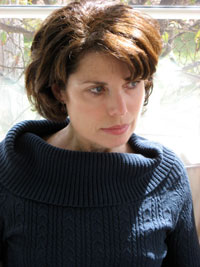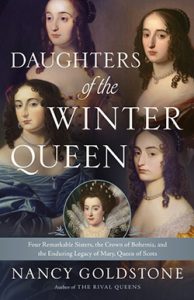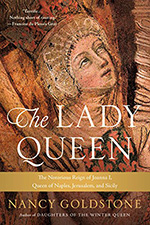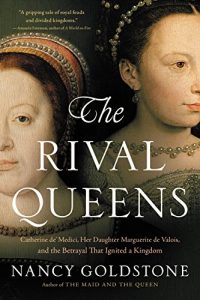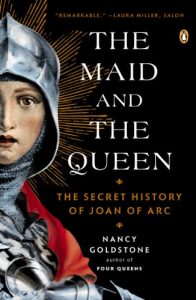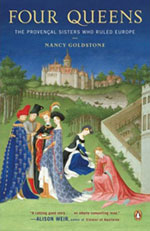Talking About Women’s History: Three Questions and an Answer with Nancy Goldstone
I first discovered Nancy Goldstone’s work when I read The Rival Queens for a Shelf Awareness review. I’ve been a fan ever since.
Nancy has a passion for medieval history and old and rare books. She is the author six works of historical non-fiction about powerful and often overlooked women in European history , including most recently Daughters of the Winter Queen: Four Remarkable Sisters, the Crown of Bohemia, and the Enduring Legacy of Mary, Queen of Scots. (FYI: She also writes books with her husband about their experiences in the world of rare and antiquarian books.)
Like many of us, Nancy didn’t take a straight path to her writing life. She graduated with honors in history from Cornell University in 1979 and received her MA in International Affairs from Columbia University in 1981. Immediately upon graduation she embarked on a hilariously brief career trading foreign currency options, an adventure which was chronicled in her first book, Trading Up: Surviving Success as a Woman Trader on Wall Street.
Personally, I’m pleased that she found her way to writing about remarkable women who helped shape history.
Take it away, Nancy!
You write about women who were powerful in their own time, but who are largely overlooked today. Why do you think we tend to forget the roles women play in history?
I don’t think we forget the roles women play in history. I think we never learned anything about them in the first place! That is because for centuries the study of history was dominated by men who, let’s face it, (1) weren’t all that interested in researching the lives of women and (2) tended to believe that men did everything anyway. It’s changing now as more and more women come into the field but in my opinion we still have a long way to go. For example, there’s a lingering prejudice in the field of European history that women did not really wield power, that their role was mostly to bear sons, and that other than that they were more or less considered part of the interior decoration of the castle. Elizabeth I is the great exception to this, of course—a new book, documentary, film, or series seems to come out about her every year. But there were so many other women just as important as Elizabeth I, who no one has ever heard of! Women of great courage and ability, whose lives and accomplishments are absolutely integral to understanding the signal events of their time. Those are the women I want to learn about. And I am thrilled to report that I have found them in every century.
If you could pick one woman in history to put into every high school textbook, who would it be?
I can think of so many women who deserve a place in school textbooks but I am going to go with Yolande of Aragon, 15th century queen of Sicily, duchess of Anjou and Maine, and countess of Provence, only because the Joan of Arc story is so well known, and to study Joan without Yolande is like omitting Abraham Lincoln from a survey course on the Civil War.
Just to recap quickly, Yolande of Aragon was the dauphin’s mother-in-law during the second half of the Hundred Years War. After Henry V walloped the French army at Agincourt in 1415, the English invaded and occupied all of western France, plus the capital city of Paris. The dauphin Charles was subsequently disinherited, and Henry went on to marry Charles’s sister and to declare himself king of both England and France.
But the dauphin did not give up. Forced to flee Paris, he regrouped his forces south of the Loire and declared war on England. Luck was against him, however, and he lost battle after battle. He began to doubt whether his cause was just, whether he really was the legitimate heir to the throne. Then, in 1428, the English, determined to break through the barrier of the Loire and take over the rest of France, launched the siege of Orléans, Orléans being one of the cities still loyal to the dauphin. And it was at this point that Joan of Arc miraculously turned up unannounced at Charles’s court, convinced him she was a messenger from God, gave him the courage he needed to fight back, and went on to lift the siege, beat the English, and lead Charles to be crowned king at Reims, thereby returning the rightful heir to the throne.
Except that it wasn’t just Joan’s voices that got her an audience at court. Although she was unaware of it, Joan had quite a bit of help from Yolande. It was Yolande who ran her son-in-law’s council. It was Yolande who pawned her own silverware to pay for the army and supplies necessary to lift the siege of Orléans; it was she who brought in new diplomatic allies and recruited the most experienced warriors to lead the French military effort against the English. Most significantly, it was Yolande who, in a brilliant political move, stepped in and secretly recruited a mystic (Joan) to help jolt her son-in-law out of his psychological paralysis when Charles (who was after all only in his twenties, very superstitious, and so vacillating that he made Hamlet look decisive) refused to give the order to fight back and instead openly debated fleeing to Scotland.
There’s much more—Yolande was hands down the most competent politician of her time (or of any time for that matter)—but what I really love about her is that she did this all so deftly, and hid her tracks so well, that for the next 600 years every historian and writer who looked at these events, including some of the greats like George Bernard Shaw and Mark Twain, totally swallowed her cover story because it was obviously far more likely that angels would come down to earth to direct the course of a battle than that a fifty year old woman with decades of political, diplomatic, and administrative experience, would actually be running the show.
What’s your next book about and when will we see it?
My next book is about Empress Maria Theresa, queen of Hungary and Bohemia, and three of her daughters: Maria Christina, duchess of Teschen and governor-general of Brussels; Maria Carolina, queen of Naples; and the world-famous Marie Antoinette, doomed queen of France.
I have known for years that I wanted to write about Maria Theresa. In fact, I have been building up to her. Maria Theresa was the only female ever to inherit the vast Habsburg empire in her own right. However, no sooner did she come into her birthright at the age of 23 than she was attacked by an overwhelming consortium of European powers who, believing her weak because she was a woman, intended to divide her lands and subjects among themselves. This turned out to be a big mistake. Despite her youth and inexperience, Maria Theresa managed through intelligence, hard work, and sheer determination to overthrow her enemies instead! Who would not wish to tell that story?
In this book I also had the chance to write about the whole tumultuous, wondrously transformative eighteenth century by following the lives of three of Maria Theresa’s remarkable daughters as well. And one of those daughters was Marie Antoinette, the most notorious queen in history! That was irresistible.
Although it is true that Marie Antoinette’s story has been told many times, I am very glad that I had an opportunity to research it myself. Before, so much of hers and Louis XVI’s behavior seemed inexplicable to me. This is my sixth book of European history; one by one, in chronological order beginning with the thirteenth century, I have meticulously examined a slew of royal courts. The rule of almost every king and queen I have ever written about has been threatened. And yet nowhere but at the court of Louis XVI had I encountered a sovereign who did not at least try to send his wife and children away to safety. Even Charles I got his wife and all but two of his six children out of England! And this was only one of a multitude of behaviors that I found puzzling. Happily, as a result of my research, I believe I have discovered the answers to all of my questions and can help illuminate the mystery and add greatly to our understanding of these key historical figures.
But while Marie Antoinette might get all the press it is her older sisters who deserve to be rescued from anonymity! They were among the most impressive women I have ever written about. Maria Christina, in addition to governing first Hungary and then the Austrian Netherlands, was a gifted artist who also managed to assemble the magnificent collection of paintings and drawings which today form the permanent exhibit of the celebrated Albertina Museum in Vienna. And Maria Carolina, the sister closest in age and affection to Marie Antoinette, was even more extraordinary—she ruled the kingdom of Naples, guided it into its Golden Age, and then fought tenaciously against Napoleon, all while being saddled in marriage to Ferdinand, king of Naples, who gets my vote for all-time worst husband ever. Maria Carolina’s hilarious dealings with her hopeless spouse were definitely among the most fun sections to write!
The book is called In the Shadow of the Empress: The Defiant Lives of Maria Theresa, Mother of Marie Antoinette, and her Daughters. It comes out in September. I love the cover, you can see it here:
A question for you: I would love to hear what you are investigating—you have kind of hinted at it and it sounds fascinating.
Allow me to introduce you to Sigrid Schultz of the Chicago Tribune:
Sigrid Schultz was the Chicago Tribune‘s Berlin bureau chief and primary foreign correspondent for Central Europe from 1925 to 1940. It was a period of big ideas and big events, and Schultz was at ground zero for many of them. She was one of the first reporters—male or female—to warn American readers of the Nazi menace. At a time when women reporters rarely wrote front page stories, her connections in Berlin society, her colloquial command of German, and her understanding of Germany’s history and politics allowed Schultz to regularly scoop her male counterparts on major news events, including the impending death of Weimar Germany’s first president in 1925 and Hitler’s non-aggression pact with Russia in 1939. William L. Shirer, author of the Rise and Fall of the Third Reich, who reported from Berlin from August 1934 to December 1940, admitted, “No other American correspondent in Berlin knew so much of what was going on behind the scene as did Sigrid Schultz.”
I am deep in the world of foreign correspondents, American newspapers. Weimar Germany, “false news,” glass ceilings, American isolationism, Nazis, the Lost Generation, the rise of radio news, daily life in Berlin and the challenges of getting the news out in the face of tightening controls over the press.
And thank you for asking!
* * *
Want to know more about Nancy Goldstone and her work?
Check out her website: www.nancygoldstone.com
* * *
Come back tomorrow for three questions and an answer with historian Lisa Levinstein, whose work expands the history of feminism in important ways.
* * *
If you’re interested in the process of writing and thinking about history, you might enjoy my newsletter, which comes out roughly every two weeks. The content is totally different from History in the Margins. In recent months I’ve discussed forgotten female photojournalists, cliffhangers, the odd experience of reading history “in real time” in the form of old newspapers, and the question of “first-naming” the subject of a biography. If that sounds like your bottle of beer, you can subscribe here: http://eepurl.com/dIft-b





